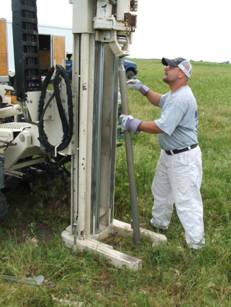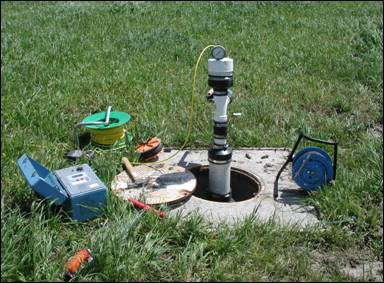2004 - 2008 Remediation of explosives and solvents at the Nebraska Ordnance Plant Superfund site at Mead, Nebraska
Vitaly Zlotnik's research | Go back to his website
Funded by Environmental Protection Agency
The military productions during World War II and the Korean War lead to groundwater contamination. One of the explosives, RDX is poorly treatable by pump-and-treat technologies. Current annual costs of cleaning contaminated aquifer are about $800,000/year with an estimated treatment time of 125 years. Instead, we attempt to oxidize RDX in-situ. Our group led by Steve Comfort, SNR injected 60 m3 of oxidant NaMnO4 spiked with a bromide tracer through recirculatory flow system. This study utilizes single-borehole techniques for aquifer characterization, multi-level slug tests in particular. Currently, we are analyzing plume movement using monitoring well network and direct push data and investigate effects of RDX oxidation.
Publications
Halihan, T., J. Albano, S.D. Comfort, V.A. Zlotnik, 2011, Electrical resisitivity imaging of a permanganate injection during in Situ treatment of RDX-contaminated ground water, Ground Water Monitoring & Remediation, published online: 16 AUG 2011, DOI: 10.1111/j.1745-6592.2011.01361.x
Albano, J., Comfort, S. D., Zlotnik, V., Halihan, T., Burbach, M., Chokejaroenrat, C., Onanong, S. and Clayton, W., 2010, In Situ Chemical Oxidation of RDX-Contaminated Groundwater with Permanganate at the Nebraska Ordnance Plant. Ground Water Monitoring & Remediation, 30: 96-106. doi: 10.1111/j.1745-6592.2010.01295.x

Bomb Manufacturing

Bomb Storage

Extraction-Injection-System Design

Aquifer Characterization with Geoprobe

Aquifer Characterization Multi-Level Slug Test

Permanganate for Injection

Day before injection: S. Comfort, W. Clayton, V. Zlotnik, and J. Albano at the site

Recirculation Control System

Surface Components of Recirculation Assembly with Safety Fence and Electrical Resistivity Lines

Monitoring Plume Advancement